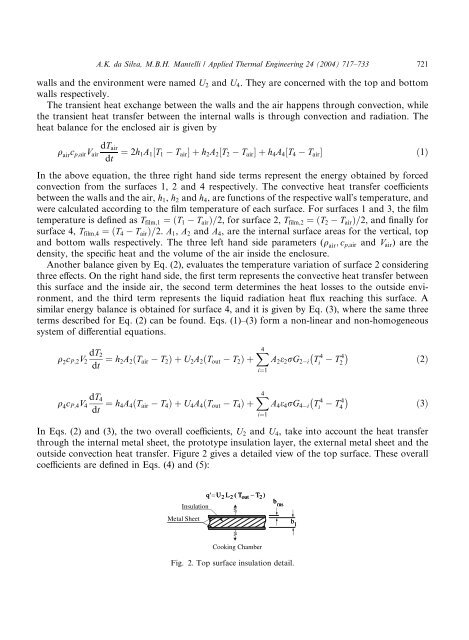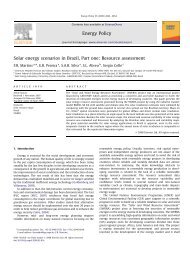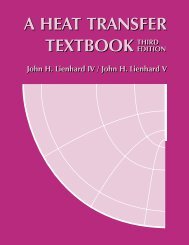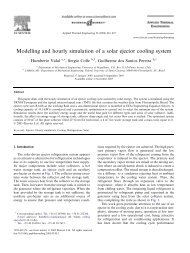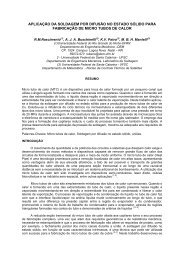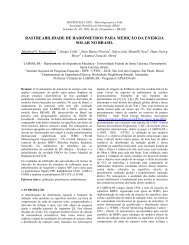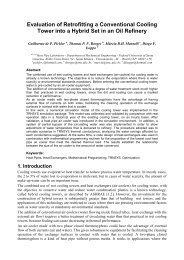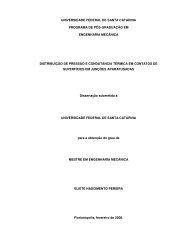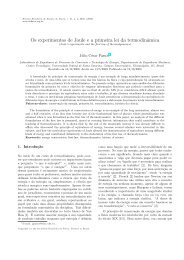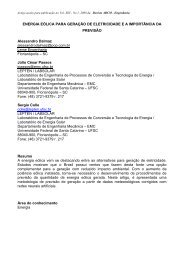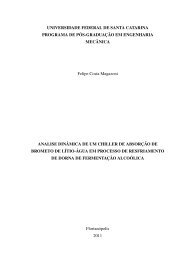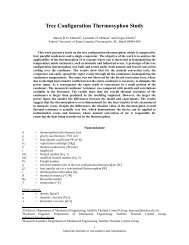Thermal applicability of two-phase thermosyphons in ... - LEPTEN
Thermal applicability of two-phase thermosyphons in ... - LEPTEN
Thermal applicability of two-phase thermosyphons in ... - LEPTEN
Create successful ePaper yourself
Turn your PDF publications into a flip-book with our unique Google optimized e-Paper software.
A.K. da Silva, M.B.H. Mantelli / Applied <strong>Thermal</strong> Eng<strong>in</strong>eer<strong>in</strong>g 24 (2004) 717–733 721walls and the environment were named U 2 and U 4 . They are concerned with the top and bottomwalls respectively.The transient heat exchange between the walls and the air happens through convection, whilethe transient heat transfer between the <strong>in</strong>ternal walls is through convection and radiation. Theheat balance for the enclosed air is given bydT airq air c p;air V air ¼ 2h 1 A 1 ½T 1 T air Šþh 2 A 2 ½T 2 T air Šþh 4 A 4 ½T 4 T air Š ð1ÞdtIn the above equation, the three right hand side terms represent the energy obta<strong>in</strong>ed by forcedconvection from the surfaces 1, 2 and 4 respectively. The convective heat transfer coefficientsbetween the walls and the air, h 1 , h 2 and h 4 , are functions <strong>of</strong> the respective wallÕs temperature, andwere calculated accord<strong>in</strong>g to the film temperature <strong>of</strong> each surface. For surfaces 1 and 3, the filmtemperature is def<strong>in</strong>ed as T film;1 ¼ðT 1 T air Þ=2, for surface 2, T film;2 ¼ðT 2 T air Þ=2, and f<strong>in</strong>ally forsurface 4, T film;4 ¼ðT 4 T air Þ=2. A 1 , A 2 and A 4 , are the <strong>in</strong>ternal surface areas for the vertical, topand bottom walls respectively. The three left hand side parameters (q air ; c p;air and V air ) are thedensity, the specific heat and the volume <strong>of</strong> the air <strong>in</strong>side the enclosure.Another balance given by Eq. (2), evaluates the temperature variation <strong>of</strong> surface 2 consider<strong>in</strong>gthree effects. On the right hand side, the first term represents the convective heat transfer betweenthis surface and the <strong>in</strong>side air, the second term determ<strong>in</strong>es the heat losses to the outside environment,and the third term represents the liquid radiation heat flux reach<strong>in</strong>g this surface. Asimilar energy balance is obta<strong>in</strong>ed for surface 4, and it is given by Eq. (3), where the same threeterms described for Eq. (2) can be found. Eqs. (1)–(3) form a non-l<strong>in</strong>ear and non-homogeneoussystem <strong>of</strong> differential equations.q 2 c P;2 V 2dT 2dt¼ h 2 A 2 ðT air T 2 ÞþU 2 A 2 ðT out T 2 Þþ X4i¼1A 2 e 2 rG 2 i T 4iT 4 2ð2Þq 4 c P;4 V 4dT 4dt¼ h 4 A 4 ðT air T 4 ÞþU 4 A 4 ðT out T 4 Þþ X4i¼1A 4 e 4 rG 4 i T 4iT 4 4ð3ÞIn Eqs. (2) and (3), the <strong>two</strong> overall coefficients, U 2 and U 4 , take <strong>in</strong>to account the heat transferthrough the <strong>in</strong>ternal metal sheet, the prototype <strong>in</strong>sulation layer, the external metal sheet and theoutside convection heat transfer. Figure 2 gives a detailed view <strong>of</strong> the top surface. These overallcoefficients are def<strong>in</strong>ed <strong>in</strong> Eqs. (4) and (5):q' U2L2(ToutT2)InsulationMetal SheetbmsbICook<strong>in</strong>g ChamberFig. 2. Top surface <strong>in</strong>sulation detail.


